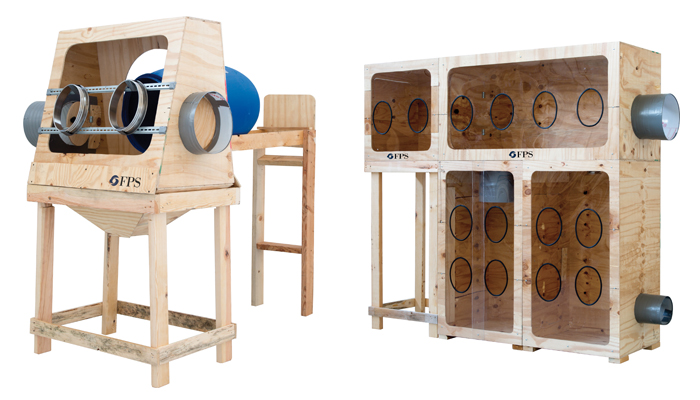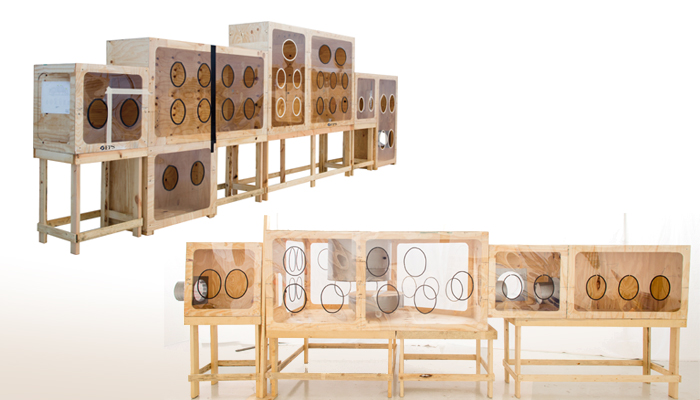
Designing a containment system is a long and elaborate process. There are many variables and infinite solutions, tailored to the customer. For this reason, the Mock-up activity is fundamental to defining the system details, simulating the operations and identifying any ergonomic problems. Taking care of this aspect allows the end user to be sure of the result, saving time and money and having the possibility to make every necessary change.
FPS is an Italian company specialised in the production of containment and micronization systems for Pharmaceutical, Biotech and Fine Chemical companies.
In the past 16 years FPS has grown to become the world leader for High Contaiment Isolators for fine powders with over 1,000 systems installed. FPS has a global technical team that supports these systems in the 40 countries where they are installed.
One of the reason for this success is that the entire design and production process of the systems takes place under one roof in the state-of-the-art plant of Fiorenzuolad'Arda (PC). This allows for optimum knowledge sharing & team work. As a result each team player becomes an expert in his/her field but beyond and it really shows in the level of innovation and quality delivered. Over the years allows, starting from a careful listening of the customer's requests to the final test before delivery.
Another reason for FPS success is our ability to listen to the specific needs of the customer, to focus on its process and to design a custom solution to address all those needs. It has been one of the strengths of FPS over the years.
Once the needs are well understood, the next step is to conduct the initial study of the project: a specialised team proposes a solution and works closely with the customer to ensure compliance with the technical specifications required.

As far as containment systems are concerned, FPS usually encourages the construction of a mock-up of the system.
"It is a structure that faithfully reproduces the machine on a 1:1 scale and provides a physical representation, as detailed as possible, of what the final system will look like. The way in which the mock-up is created allows the designer and the customer to easily make any changes and improve ergonomics during the verification stage” - explains Ms. Ilenia Lindi, Head of Project Management at FPS.
"A mock-up is created to outline the general aspects and the critical details that will make up the final machine, in order to establish the optimal location of all the components, simulate the planned operations and examine any issue that were not apparent previously. It is a team effort between the customer and the manufacturer. The customer is supported in each step of the way by the project team who, under the coordination of the Project Manager, works together with the customer to find the best solutions".
The steps to consider when producing a mock-up are:
• 3D Design of the isolator
• Draw the mock-up
• Build the isolator mock-up
• Simulate the process equipment in the isolator (or best: use actual equipment)
• Install the polycarbonate windows and position the glove ports
• Simulate the process on the mock-up with the customer and the project team
• Final report with the details of the findings and proposed solutions.
Before making the mock-up, a careful preliminary study of the system is carried out, starting from the supply specifications and also considering the space available at the installation site and the process equipment to be integrated into the machine (such as process machines or different types of handling containers). The 3D model of the plant is the starting point for the construction of the mock-up.
In order to achieve the best result, it is necessary to simulate all the operations that the operator will perform inside the isolator; FPS therefore not only simulates the system, but also the main process equipmentinside the isolator and the material to be handled.
"Sometimes it happens that in the offer stage, the customer does not recognise the importance of this mock-up phase and considers it as ‘redundant’ because of the large experience of FPS in the design and construction of containment systems.
However FPS always stongly suggests not to skip the mock-up phase which is always eye-opening for some aspects of the isolator. When FPS's suggestion is followed, customers who comes on site say they really enjoy touching with their hands what their machine will look like and take great pleasure ‘playing’ with all moving components. In most cases customers evaluatealternate solutions other than those they had initially considered. I also have been in situations where I spend a whole day with a customer simulating on the mock-up, looking for alternate solutions that he/she thought could be better, and the customer ends up confirming the initial solution we proposed. However, I did not feel that this time was wasted at all, quite the contrary! It is very important to us that the end user is fully convinced of how the final solution will be implemented in the best configuration" - Lindi continues.

"Since these systems are complex and require major economic investments, this mock-up phase gives us the opportunity to evaluate at thedesign stage all the integrations that involve extra costs but also possible cost reductions. For example, sometimes we can eliminate a working chamber because that entire process can be carried out in a single chamber. This typically significantly reduces the overall system footprint and the final cost for the end user.”
The great advantage of making a mock-up is to let real end users perform the manipulations and ‘play’ with the machine and then define/observe the operations as they will actually be performed.
"Recently for the ergonomic test of very large and complex isolator project- continues Lindi–the customer sent a large delegation to the mock-up test. The team was made of the project manager, the process engineer, the electrical manager, the operator and some technicians of the engineering company that followed the project. We worked together 4 days to verify the solutions proposed and each contributed its part.
In our experience we never had an instance when a customer was dissatisfied of the final system after attending a mock-up test. On the contrary, even the most skeptical customers recognise the usefulness of the work carried out. For example, we have recently made an isolator similar to one already in operation in the same company. We could have ‘skipped’ this step and reproduced the same machine. Instead, in agreement with the customer, we invested a day of work together to study a new mock-up and evaluate, based on their experience, the improvements to be adopted for this new project. In the end a few design changes were made.”
This mock-up phase can be a real plus for the electrical configuration. The Technical Director, Mr. Carlo Corsini, explains: "It is true that the mock-up is more useful for an ergonomic, mechanical and space evaluation, but it is very advantageous also from the electrical point of view. For example, we are working closely with a US customer to propose a solution for the US market, that applies different standards from those in Europe.”
FPS strongly believes that this mock-up phase is critical because it allows to get a very accurate idea of the machine that will be manufactured, to optimise the ergonomics and the flow of material. The other achieve savings in terms of costs and time on both sides.
"The creation of the mock-up takes 2-3 weeks in the development of the project, which in the case of projects with tight construction deadlines can be a significant time," says Gianola, President and Sales Director. "However, experience has taught us that investing in mock-ups can avoid problems during installation/commissioning and in the use of the system, which might otherwise take much longer to be resolved.”
As always, the objective of FPS is to be of service to the Pharmaceutical and Fine Chemical industries. The mock-up is one of the tools that helps us fulfill 100 per cent of the needs of our customers.